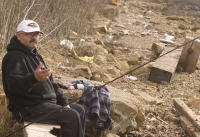Richmond Superfund site toxic pollution increasing
By Hannah Dreier
Contra Costa Times
Posted: 01/03/2012 06:57:09 PM PST
Updated: 01/04/2012 04:28:45 AM PST
Click photo to enlarge

Leonardo Bravo of Richmond, Calif., 65, says he's not concerned about warnings of contaminated...
Leonardo Bravo likes to fish on the Richmond shoreline because it relaxes him.
He might not find it so calming if he knew that fish at a nearby Superfund site are becoming increasingly toxic more than a decade after the channel was cleansed of pollutants.
Despite the cleanup dredging, levels of two pesticides not used in the United States since the early 1970s -- DDT and dieldrin -- are rising in fish around the site, according to a U.S. Environmental Protection Agency review.
Some fish tested at the site, which includes two waterways in Richmond's Inner Harbor, are now more contaminated than those tested before the cleanup.
"I'm disappointed in the EPA for not doing a better job of cleaning it up," said Councilman Tom Butt. "When you have concentrations of toxic chemicals at the level they're reporting, it's got to have an effect."
Sharon Lin of the EPA oversaw the initial cleanup of the Lauritzen Channel and Parr Canal in 1996. She remembers the initial hope and ultimate disappointment of the project.
"We thought the system would come back and the concentration levels would be safe," she said.
Instead, after initially dropping, toxicity indicators began increasing year over year and are now largely back to where they were before the intervention.
"We're no longer using DDT and dieldrin, so it's sitting somewhere, contributing to contamination," Lin said.
DDT concentrations in Lauritzen Channel anchovies have increased by a factor of 30 since 1994. DDT concentrations in surf perch are back to 1994 levels.
Fishing is not allowed at the site, but the fish threaten human health nonetheless because they swim into the rest of San Francisco Bay and fishers trespass in the polluted waterway, the EPA concluded.
A block from the Superfund site, a waterfront sign advises against eating more than two fish from the bay a month.
City leaders say residents fish all over the Richmond shoreline despite posted warnings.
"They see the signs, but they catch the fish and it looks good and tastes good," Butt said. "It's like, 'Well that's just another government thing.' "
The story of the Lauritzen Channel begins in the 1940s, when the United Heckathorn chemical plant processed DDT into products near Cutting Boulevard and Fourth Street.
Once a popular chemical used to kill insects carrying malaria and yellow fever, DDT by the 1960s was found to be killing fish and preventing birds from reproducing. It was banned in this country in 1972.
The pesticide lingered in the dirt around the former plant and in sediment of the two waterways, creating one of the bay's worst toxic hot spots.
In the 1980s, the state Department of Fish and Game found mussels in the area had the highest levels of DDT recorded in California.
A decade later, 107,000 tons of sediment were dredged, put on rail cars, and sent to a hazardous-waste dump.
But the cleanup didn't capture all the chemical-laced sludge, said Penny Reddy, who now manages the cleanup for the EPA.
Some harmful mud was left under piers and in tight corners, and some might still be sloughing off the embankment.
"What happens over time is that with the tides coming in and out and ships coming in, it redistributes all the contaminated sediment," she said.
The difficulty of cleaning up waterways such as this one has been one of the surprises of the Superfund project that Congress launched in 1980.
"A lot of the sediment sites across the U.S. have not been fully cleaned up because it turned out to be difficult," Reddy said. "They're dynamic environments, and there aren't a lot of options for remediation."
The EPA will start working on a plan to clean up the site for good and will post new warning signs.
Meanwhile, Bravo, 65, has seen the signs, but goes fishing in the inner harbor several times a month anyway because it helps him pass the time.
A recent afternoon found him casting a line from a driftwood bench near Point Molate. He said that he feels comfortable eating his catch because he knows when fish are unhealthy.
"Fish are very delicate and they couldn't survive if something was sickening them," he said.
"Still, I know the water is poisoned and I wouldn't go in it even to swim."
Contact Hannah Dreier at 510-262-2787. Follow her at Twitter.com/hannahdreier.
Details
The EPA's recent five-year
review of the United Heckathorn Superfund site can be read at 1.usa.gov/sG3gJb.